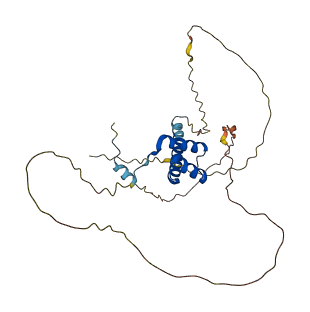Descriptions
The autoinhibited protein was predicted that may have potential autoinhibitory elements via cis-regPred.
Autoinhibitory domains (AIDs)
Target domain |
|
Relief mechanism |
|
Assay |
cis-regPred |
Accessory elements
No accessory elements
Autoinhibited structure

Activated structure

1 structures for Q6F2E2
| Entry ID | Method | Resolution | Chain | Position | Source |
|---|---|---|---|---|---|
| AF-Q6F2E2-F1 | Predicted | AlphaFoldDB |
No variants for Q6F2E2
| Variant ID(s) | Position | Change | Description | Diseaes Association | Provenance |
|---|---|---|---|---|---|
| No variants for Q6F2E2 | |||||
No associated diseases with Q6F2E2
1 GO annotations of cellular component
| Name | Definition |
|---|---|
| nucleus | A membrane-bounded organelle of eukaryotic cells in which chromosomes are housed and replicated. In most cells, the nucleus contains all of the cell's chromosomes except the organellar chromosomes, and is the site of RNA synthesis and processing. In some species, or in specialized cell types, RNA metabolism or DNA replication may be absent. |
2 GO annotations of molecular function
| Name | Definition |
|---|---|
| DNA-binding transcription factor activity, RNA polymerase II-specific | A DNA-binding transcription factor activity that modulates the transcription of specific gene sets transcribed by RNA polymerase II. |
| RNA polymerase II cis-regulatory region sequence-specific DNA binding | Binding to a specific upstream regulatory DNA sequence (transcription factor recognition sequence or binding site) located in cis relative to the transcription start site (i.e., on the same strand of DNA) of a gene transcribed by RNA polymerase II. |
5 GO annotations of biological process
| Name | Definition |
|---|---|
| BMP signaling pathway | The series of molecular signals initiated by the binding of a member of the BMP (bone morphogenetic protein) family to a receptor on the surface of a target cell, and ending with the regulation of a downstream cellular process, e.g. transcription. |
| determination of ventral identity | The regionalization process that results in the determination of the identity of part of an organism or organ where those parts are of the type that occur in the ventral region. Identity is considered to be the aggregate of characteristics by which a structure is recognized. |
| negative regulation of DNA-templated transcription | Any process that stops, prevents, or reduces the frequency, rate or extent of cellular DNA-templated transcription. |
| negative regulation of transcription by RNA polymerase II | Any process that stops, prevents, or reduces the frequency, rate or extent of transcription mediated by RNA polymerase II. |
| regulation of transcription by RNA polymerase II | Any process that modulates the frequency, rate or extent of transcription mediated by RNA polymerase II. |
| 10 | 20 | 30 | 40 | 50 | 60 |
| MEKRPYSVAW | LSESSQRKPL | CTNVDLLGYK | SGNPDLPPNR | EYNVSLPSRV | ILPTPDYREK |
| 70 | 80 | 90 | 100 | 110 | 120 |
| ENYCGRNVHN | GERSPPVRDQ | LHFHPAPQEL | TTSRRTSIEV | SAESSTDQRV | IGMTDTNKKT |
| 130 | 140 | 150 | 160 | 170 | 180 |
| ISVCDEDAAS | RARTKFTAEQ | LEELEKSFKE | NRYIGSSEKR | RLSKVLKLSE | NQIKTWFQNR |
| 190 | 200 | 210 | 220 | 230 | 240 |
| RMKFKRQTQD | ARVEAFFSGL | YLPYYGYPDL | PTPGYSVQSE | FPVLAPQTMA | ASSIPFGPLH |
| 250 | 260 | 270 | 280 | ||
| STVMSPGLHP | AIPSANLGSY | PCSSMLVRPI | LNEPTRQRYS | PY |
